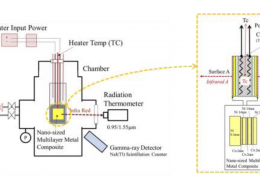Your Source for Open Science and Emerging Energy Technology
CMNSCIENCE in the NEWS
George Washington University Professor David J. Nagel presented on The Status, Momentum, & Potential of LENR at New York University, where he is collaborating on a project on AI and LENR with a team led by Professor Anasse Bari. Explore the LENR ChatBot here.

Le Société Française de la Science Nucléaire dans la Matière Condensée (SFSNMC) has posted Énergie hydrogène métal dans des Nanopoudres obtenues à partir d’hydrotalcites with a French transcript. Choose Settings, Subtitles/CC, French, to view the transcript.
HAPPENING NOW

16th International Workshop on Anomalies in Hydrogen Loaded Metals
IWAHLM16 The Bill Collis Memorial Workshop
September 2 – 4, 2024 in Strasbourg, France
with a Special Invitation from CleanHME
at the European Parliament September 5, 2024
More is posted on the IWAHLM16 [website]. Register for online access or physical attendance here. Meet us Sunday night at the meeting venue, the Sofitel Hotel, for an early get-together. See a Press Release here.
Registration for the Workshop is at 80+ with full-on global presence including top research and development labs reporting on the latest experimental and prototype results. Theoretical modeling has a strong presence in the draft program, which includes Lattice Energy Generator LEC demonstrations and opportunities for industry networking. Presentations begin Monday Sep 2 at 9AM in the morning Strasbourg, France time. Online attendees can find their relative times for morning and afternoon Livestream sessions here at worldtimebuddy. A link to attend the sessions online will arrive in your mailbox before the event.
Remember that trains are likely full at this time, and you will not be able to book a seat to Strasbourg on-the-fly. Renting a car is likely your only option, if you plan to attend physically.
*IMPORTANT *
IWALHM16 participants are also invited to a special event at the European Parliament building in Strasbourg on Thursday, September 5 for a program courtesy the European CleanHME project. [more here] The deadline to access this event in person has passed.
IWALHM16 is organized by the SFSNMC https://www.sfsnmc.org/ and the ISCMNS https://iscmns.org/ and sponsored by Anthropocene Institute https://anthropoceneinstitute.com/ and Clean Planet, Inc https://www.cleanplanet.co.jp/and Infinite Energy Foundation https://infinite-energy.com/.
Thursday’s program at the European Parliament building is sponsored by CleanHME Consortium http://www.cleanhme.eu/
GET LIVE UPDATES from IWAHLM16 at this LENR-forum thread.
You can get complimentary online access to IWAHLM16 if you are able to report on events as hey happen on LENR-Forum.com. Interested? Contact us here!
Visit Your LIBRARY
Monthly downloads are at a low during summertime. School starts soon…. Full stats here.
July….. 10,027
June…. 14,044
May…… 18,130
Newly uploaded papers are listed on the Recents page. Search the LENR Library using AI capability at https://lenrdashboard.com/ and https://lenrbot.com/index.html.

Additional libraries of papers can be found on the LENR Reference Site, a project of New Energy Times. [visit] The Dieter Britz Library of papers posted on this page. Find the Early Soviet/Russian LENR Bibliographic Index here.

A pre-print is available of the paper An Experimental Study on Deuterium Production from Titanium Hydride Powders Subjected to Thermal Cycles by Luca Gamberale of University Milano-Bicocca and Giovanni Mondonese of Free University of Bozan-Bolzano.
From the Abstract: An extensive multi-year experimental study was conducted to investigate the potential production of deuterium from titanium hydride (TiHx) powders subjected to specific thermal cycles. The results reveal an anomaly in the deuterium-to-hydrogen ratios. Mass spectrometry analyses show an increase in deuterium abundance, with three independent methods confirming the excess deuterium. This study was motivated by theoretical predictions suggesting the generation of slow neutrons within metal hydrides when exposed to coherent excitations. Our findings align with direct measurements of neutron emission by TiHx powders under cavitation in liquid water, as recently published by Fomitchev-Zamilov. Read the full text here.
Exploring Helium Retention from Technical Materials: Development and Investigation by Andrew K. Gillespie, Cuikun Lin, Django Jones, Sandeep Puri, and R.V. Duncan is published on ScienceDirect here.
From the Introduction: …Within the LENR community, researchers have been actively searching for the presence of helium-4 as a crucial signature and evidence of nuclear reactions. This is particularly important for correlating helium measurements with excess heat observations. However, several challenges arise in this pursuit. It’s known that ambient air naturally contains helium at a concentration of approximately 5.2 parts per million (ppm). Consequently, helium can easily diffuse or be absorbed into experimental apparatus, leading to contamination that may significantly impact the obtained results.
In this study, various metals including palladium, stainless steel, and platinum, as well as polymers and ceramics such as Nylon and PTFE underwent testing to assess helium retention characteristics before heating, after heating, or during complete evaporation of the technical materials. Of particular focus were metals like stainless steel (SS) and palladium (Pd), aiming to precisely quantify trapped helium within wire lengths through heating beyond their respective evaporation thresholds.
Anthropocene Institute (AI) reports on the Accelerating Deployment of Versatile, Advanced Nuclear for Clean Energy (ADVANCE) Act, a new U.S. law signed by President Biden to “boost” nuclear energy in the States. The rare bi-partisan legislation passed the U.S. Senate by a vote of 88-2 and the House by 393-13. [read the breakdown]
Anthropocene Institute co-sponsored the ARPA-E Technology Showcase hosted at Capitol Hill’s Senate Office Building, and AI’s Hilda Palencia attended. Director of ARPA-E Dr. Evelyn Wang delivered an introduction to the event. See photos and a listing of the ARPA-e projects showcased here.
Members of Anthropocene Institute’s Solid State Fusion (SSF) team participated in the American Nuclear Society (ANS) meeting held in Las Vegas where a session dedicated to Low-Energy Nuclear Reactions (LENR) was held. [program] Five different research groups presented, including groups affiliated with Tohoku University, National Taiwan University, National Taiwan Normal University, NASA Marshall Space Flight Center, and the Indian Institute of Technology Kanpur. Read the full report with photos here.

MIT is seeking a POSTDOCTORAL ASSOCIATE to join an interdisciplinary research team investigating low-energy nuclear reactions in an ARPA-E research program for the Materials Science and Engineering (DMSE) and Electrical Engineering and Computer Science (EECS)-Yet-Ming Chiang Group and Quantum Energy Science Group. The work will investigate reports of purported nuclear binding energy release in metal hydrogen systems from low-energy stimuli such as laser pulses, induced phase transitions, etc. Find out more and apply here.

Eric Ziehm has published An experimental investigation of low energy nuclear reactions in a DC glow discharge, a PhD thesis about his work at University of Illinois Urbana-Champaign with Professor George Miley. Read or download the paper here.
QuiRan Lab
On Philosophy and Cold Fusion – A Letter from Hang Zhang from QiuRan Lab begins “I have been considering a philosophical question recently, and of course physics is a branch of philosophy. Oppenheimer said, “Deep things in science are not discovered because they are useful; they are discovered because they are possible to discover. This is a profound and necessary truth.”” [read]
GET LINKED * BECOME a SPONSOR * CONTACT LENR-FORUM
TECHNOLOGY R&D

The 65th anniversary event of Miura Co., Ltd., “Miura Connecting to the Future,” featured Quantum Hydrogen Energy as a potential energy source for the future.
From the article: “Clean Planet introduced “Quantum Hydrogen Energy,” a dream technology that can produce more than 10,000 times the energy of conventional hydrogen combustion, and is currently jointly developing a boiler with MIURA.” [read]
Take a virtual tour of the Fair here. Follow the thread on LENR-Forum.


Credit. Author, Bin-Juine Huang
Bin-Juine Huang of National Taiwan University is developing technology based on Cavitation Induced Fusion CIF. A press release here describes the work.

Hindu businessline reports HYLENR demonstrates cold fusion technology to generate clean energy [read]. From the article: …”In a live demonstration here, the product achieved a consistent 1.5x heat amplification (150 watts equivalent heat) from a 100W electrical input. Mahankali Srinivas Rao, CEO, T-HUB, formally launched the product in the presence of the founders of HYLENR.”
…”Siddhartha Durairajan, Chief Executive Officer for HYLENR said: “The patent for the product validates the inventiveness of the technology, and the viability of integrating LENR with existing power generation systems to enhance efficiency and reduce reliance on traditional energy sources. The proposed approach leverages LENR to amplify electricity from renewable and non-renewable sources, ultimately aiming for a 2.5 times power output increase.”
HYLENR [visit] also released this video on HYBIZ TV.

Securities.io published Cold Fusion Reignite Dreams Of Clean Energy Without Hot Plasma by Jonathan Schramm who asks the question, Does Nuclear Fusion Mean Hot Fusion Only? [read]
Become a Member of ISCMNS. Subscriptions start at €25 for twelve months. Get a Lifetime membership for €200. Join the ISCMNS and enjoy early access to research, special rates at conferences, workshops, and online webinars. Apply online here today!
RED ALERT EARTH
Conservation International August 6, 2024 — Study: As global temperatures rise, climate ‘tipping points’ loom [read]
NOAA August 12, 2024 — Earth just had its warmest July on record. July was the globe’s 14th month in a row of record warmth. [read]
Frontiers in Nature June 24, 2024 — Conservation Imperatives: securing the last unprotected terrestrial sites harboring irreplaceable biodiversity
From the Abstract: Ambitious biodiversity goals to protect 30% or more of the Earth’s surface by 2030 (30×30) require strategic near-term targets. To define areas that must be protected to prevent the most likely and imminent extinctions, we propose Conservation Imperatives—16,825 unprotected sites spanning ~164 Mha of the terrestrial realm that harbor rare and threatened species. We estimate that protecting the Conservation Imperatives would cost approximately US$169 billion (90% probability: US$146—US$228 billion). Globally, 38% of the 16,825 sites are either adjacent to or within 2.5 km of an existing protected area, potentially reducing land acquisition and management costs. These sites should be prioritized for conservation action over the next 5 years as part of a broader strategy to expand the global protected area network. The expansion of global protected areas between 2018 and 2023 incorporated only 7% of sites harboring range-limited and threatened species, highlighting a renewed urgency to conserve these habitats. Permanently protecting only 0.74% of land found in the tropics, where Conservation Imperatives are concentrated, could prevent the majority of predicted near-term extinctions once adequately resourced. We estimate this cost to be from US$29 billion to US$46 billion per year over the next 5 years. Multiple approaches will be required to meet long-term protection goals: providing rights and titles to Indigenous Peoples and Local Communities (IPLCs) conserving traditional lands, government designation of new protected areas on federal and state lands, and land purchase or long-term leasing of privately held lands.
MOVE NOW TO ASSIST WILDLIFE IN YOUR AREA
Before it’s out, it’s at
Be a LENR News author. Submit your work to the LENR-Forum News here.
DISCLAIMER Mentions of any investment funds or private business do not indicate endorsement by the Authors or LENR-forum members. LENR-forum supports metal-hydrogen energy and solid state fusion as a zero-carbon solution to global energy needs. By publicizing community activity, we do not intend or seek to promote any one entity over any other. We do not give investment advice or suggestions. Due diligence is required before investing in any venture. Information is provided solely for educational and research purposes.

Do you have a news or article that deserves a wider distribution?
Or maybe you have a talent that complements us?
Get in touch!

















